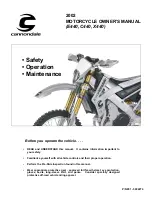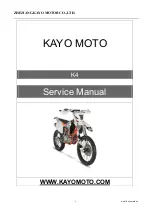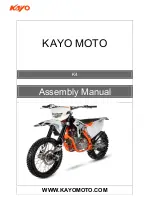
ENGLISH
21
Replacing the front brake pades*
Remove the front wheel (see front wheel chapter).
Press brake shoes apart with a suitable screwdriver to put the brake pistons
in their basic position.
Remove the lock washer
1
from the screw as well as fixing screw
2
and
take the brake shoes out of the brake caliper. Clean brake caliper
thoroughly with compressed air.
Mount both brake shoes and fasten with the fixing screw. Tighten the
fixing screw to 10 Nm. Mount the lock washer. Align the brake shoes,
mount the front wheel (see chapter "Mounting the front wheel").
WARNING
– I
T IS VERY IMPORTANT TO KEEP THE BRAKE DISK FREE FROM OIL AND FATTY MATTERS
.
O
THERWISE
,
THE BRAKING EFFECT WOULD BE STRONGLY REDUCED
.
– A
FTER ASSEMBLY
,
CHECK IF CIRCLIPS HAVE BEEN FITTED CORRECTLY
.
– H
AVING PERFORMED ANY WORK ON THE BRAKING SYSTEM
,
ONE MUST ALWAYS
ACTUATE THE HAND BRAKE LEVER OR FOOT BRAKE LEVER
,
RESPECTIVELY SO AS TO
ENSURE THAT THE BRAKE PADS WILL LIE AGAINST THE BRAKE DISK AND THE PRESSURE
POINT IS ESTABLISHED
.
– D
O NOT UNSCREW ANY OTHER SCREWS ON THE BRAKE CALIPER OR YOU WILL HAVE
TO BLEED THE BRAKE SYSTEM
.
Changing basic position of the brake pedal *
The basic setting of the foot brake pedal can be changed by turning the end
stop roller
3
. Using the push rod
4
, the free play on the foot brake pedal
must be set.
Measured on the outside, the foot brake pedal must have 3-5 mm of free
play before the push rod can move the piston in the brake cylinder (to be
recognised from the resistance on the foot brake pedal).
!
CAUTION
!
I
F THIS CLEARANCE IS MISSING
,
PRESSURE ACCUMULATES IN THE BRAKING SYSTEM AND
THE BRAKE PADS BEGIN TO RUB
. T
HE BRAKING SYSTEM OVERHEATS AND CAN FAIL
COMPLETELY IN EXTREME CASES
.
1
2
3
4
3-5mm
















































